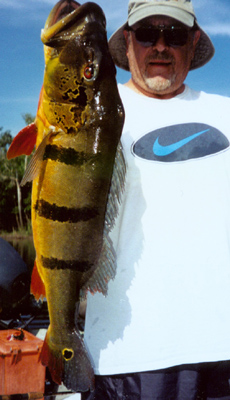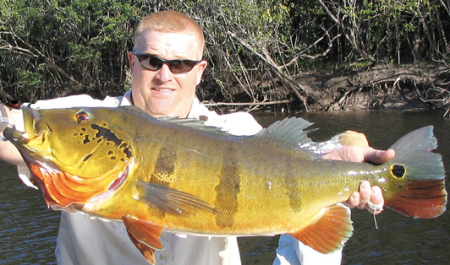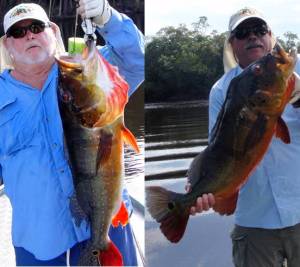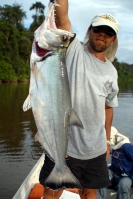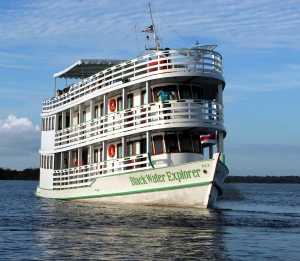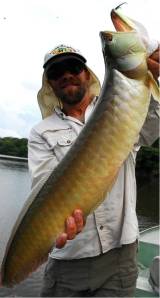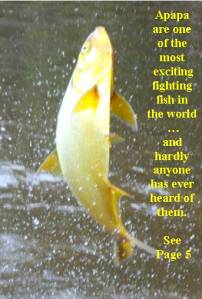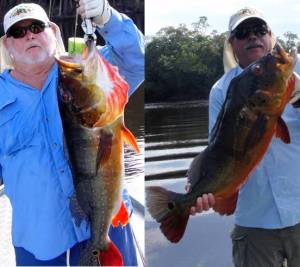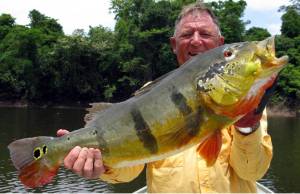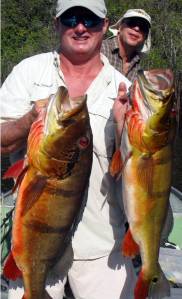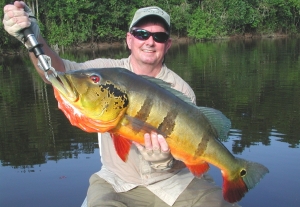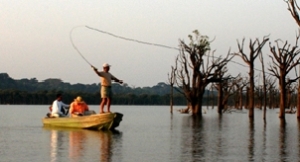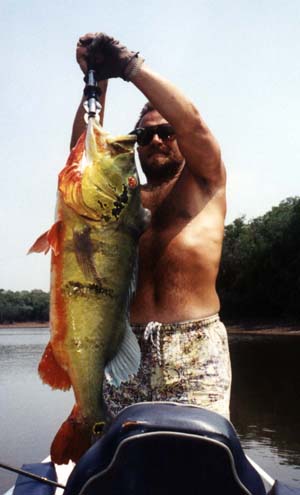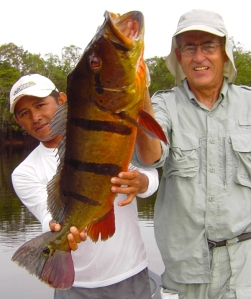
The right gear allows productive monster peacock bass fishing.
Well, you’ve made the decision to go to the Amazon, to fish for the world’s greatest sportfish in the home of the biggest peacock bass found anywhere. Like any first time Amazon peacock bass angler, you’re understandably excited. The fish of your dreams is waiting to ambush your lures in an exotic place you can hardly imagine. You’ve invested time, money and emotional energy and you’re charged up and ready to go. This, however, is the time to keep a cool head and make sure that you are properly prepared. As in the well-known credit card commercial;
Booking an Exotic Fishing Trip – $4000 to $5000
Airfare to get there – about $1200
Being properly prepared – Priceless!!!
Don’t walk into a tackle shop and ask them to outfit you for peacock bass. Almost unfailingly someone who has never seen a peacock bass and has no idea what to throw at them will load you up with overly heavy, inappropriate gear. Quite likely you’ll arrive in the Amazon well equipped for tuna perhaps, but not for peacock bass. Before you even start packing your bags and before you think about the tactics and techniques necessary to catch them, you need to know what rods, reels and lures will serve you best. Let’s look at what tackle should go in your gear bag, step by step. These recommendations are for the Amazon giants, Cichla temensis, and, although they will still have utility outside the Amazon basin, they are not specifically geared to smaller, generally less aggressive species.
Step 1. The Lures – When peacocks are in full feeding mode, anglers could probably toss their shoes into the water and get strikes. Lure selection, however, becomes much more critical as soon as conditions make the fish a little more selective. To optimize their lure selections, anglers should focus on the following four classes of lures;

The Woodchopper
Prop Baits – The classic peacock fisherman’s tool, these big, gaudy plugs are best known for the spectacular surface explosions they elicit. Anglers should bring at least a half dozen assorted samples, concentrating on the larger sizes (up to 2 oz.). Among the best choices are Luhr-Jensen Woodchoppers, Caribe Lures Pavon Props and Highroller’s Magnum Riproller. Although smaller and lighter versions of these lures are available and some may find them easier to cast, they do not always perform as well. Since they can only carry smaller, less durable hooks, they often lead to bent metal and heart-broken anglers.

Yo-Zuri Crystal Minnow
Swimming Plugs – A great all-purpose tool for catching peacock bass. These baits are easy to use and will work under almost all conditions. Recommended models include; Yo-Zuri Crystal Minnow (3/4 oz., floater), 7 inch Cotton Cordell Red Fin, large Bombers and floating Rapala Magnums, among others. Bring a half dozen.

Heddon Super Spook
Walking Stick Baits – Oftentimes a slowly sashaying stick bait will trigger amazingly violent peacock bass surface strikes. Effective models include; Zara Spook (3/4 oz.), Super Spook (1 oz.) and Mega-Bait (2 oz.). Bring 3 or 4. Note that the smaller models will require hook upgrades.

Peacock Bass Rattle Jig
Peacock Bass Jigs – This is the ultimate peacock bass bait. Nothing catches as many peacocks as a properly fished 1/2 oz. peacock jig (strip it—don’t jig it). Either tie your own or buy a high quality pre-tied model, such as Sidewinder’s Peacock Rattle Jig. Bring at least a dozen (or more if you’ll be fishing piranha laden waters).
Other Lures – 95% of the peacock bass on our trips are caught by the 4 classes of lures detailed above. Sometimes, however, conditions do call for a different, more specialized tool. Carry at least one or two large spoons (Johnson’s silver minnow – 1 and 1/8 oz.), a few big Rattletrap lures, and perhaps a small, deep diver. Of course, every angler has their favorite lure, one that they just know is going to change the face of peacock fishing and land them a world record. By all means, bring it, but don’t bring too many and don’t get your hopes too high on it. Weight limits and space considerations demand that you focus on the most productive items.
Step 2. The Rods and Reels – Peacock anglers often bring overly heavy gear. Yes, the peacock is an extraordinarily powerful and violent fish, but rod and reel selections should be made based on the lures you’ll be using. Heavy tackle makes you tired, resting anglers don’t cast and lures in the boat don’t catch fish. Keep your gear reasonably light so that you can fish steadily, make good casts and properly work the lures that will ultimately bring in your trophy.
Based on the lures recommended in Step1, Here is a summary of the rods and reels best suited to fishing with each of the lure types.
Medium/Heavy Outfit – This rig will effectively cast and work the heavy prop baits. Whether you’re a baitcaster or spin aficionado, select a Medium/Heavy rod (like the G. Loomis Escape MHC – we recommend 3-piece travel rods). Avoid overlong (no longer than 7’) rods and definitely no long handles. They just make working the lure more difficult.
Select a fast-retrieve reel. For spin fishermen, this is easy; any medium sized reel (i.e. Shimano 4000 series) has a fast retrieve. For baitcasters, you’ll need a 6.3:1 or faster retrieve and these are not the norm in mid-sized gear. We recommend an Ambassadeur C4 5500 series, a Shimano Corado reel (both modestly priced) or a Shimano Calais (more expensive). Don’t neglect this parameter of equipment selection. Slow retrieving reels will make it difficult to properly work your lures and leave you very tired at the end of the day. If you can skillfully operate either type, spin or baitcaster, the baitcaster is the better choice here due to its higher percentage of tangle-free landings and its lower casting trajectory.
Medium/Light Outfit – This is recommended for jigs and other small, lightweight baits. In the hands of an experienced fisherman with a properly set drag, a quality outfit in this category will efficiently handle even the largest peacock bass while providing unparalleled casting ease, efficiency and accuracy with light lures. If you can skillfully operate either type, the spinner is the better choice here. A good rig would be a Loomis Escape MLS and Shimano 2500 spinning reel.
Medium Outfit – This is an American black bass fisherman’s bread and butter tool. Bring your favorite. Retrieve rate is not critical with this rig. A good example would be a 7 foot medium rod (Loomis Escape MC) and a Shimano Calcutta 250 size reel. Use this for Zara Spooks, Super Spooks, Yo-Zuris and other medium size baits. This rod also makes an excellent backup for either of the other two rods described above (rods break).
Step 3. Line – Peacock bass fishing in the Amazon requires braided line. Leave the mono home. Peacock’s tough mouths call for a solid, stretch-free hookset. Great tensile strength is necessary to withstand their violent strikes while the need for casting accuracy demands a thin, light, flexible line. Monofilament’s characteristics will not serve this fishery well. And don’t bother with leaders or clips. They just provide one more point for potential system failure. Tie right to the lures. It’ll help get rid of worn or frayed line tips and make lure action optimal. Even if you’ve never used braid before, don’t worry, the knots are simple and Brazilian guides know the knots and how to use the line. You’ll quickly become comfortable.
Braid Options – For spinning tackle, we recommend a quality thin braid such as Power Pro. Use 30 lb. for medium and light gear. Lines up to 50 lb. test are appropriate for your heavier gear. For baitcasting gear use 30 or 50 lb. test for the lighter rigs. A heavier test thin braid (65 lb. test Power Pro) is recommended for the heavier rigs. These will prove to be more resistant to backlashes and “digging in”. A hint for new braid users; When tying your line onto your reel’s arbor, place a small piece of electrical tape over the first turn of line. Subsequent wraps will dig into the tape and help to anchor the braid firmly onto the arbor. This will prevent the line from spinning on the spool and will assure that your drag works properly. Learn the “Palomar” knot. All braid packages come with instructions for this simple and super-strong knot.
A Warning – Despite their high tensile strength, even these powerful lines will not allow you to out-muscle a peacock. Their explosive initial bursts will break these strong braids like sewing thread if your drag is not properly set (meaning too tight or locked down). Even if your line survives the initial onslaught, something else will give. Hooks will straighten, rods or reels may break. Peacock bass cannot be “horsed”. Use a properly set drag (you must be able to manually pull out line, although with some effort) and use your angling skills to lead fish away from structure and slowly and steadily tire them out.
Step 4. Traveling Light – Be judicious with your tackle selections. Almost all charter operators have a 44 lb. (20 Kilo) weight limit. Anglers often find they bring material they never use.
Step 5. Where to Buy – All of the individual items recommended here, as well as complete destination specific packages are available at www.Tackle-box.net or call 866 832-2987 or 866 431-1668 for assistance. Lower priced or higher value alternatives are also available.

Blackwater Explorer
Most higher end trip operators make rods and reels available for their clientele. Acute Angling has stocked the Blackwater Explorer yacht with the appropriate mix of Loomis rods and Shimano reels, free for clients to borrow, so that no one ends up without suitable equipment. Of course, you’re always welcome to bring your own gear. We’re well aware that anglers tend to more comfortable and skillful with equipment they’ve grown accustomed to. Lures are a different story and are best purchased before you leave. They may be unavailable at your destination and they will certainly be more expensive.
Now that we’ve gotten some of the basics covered, we’ll start talking about how to pack and prepare and then how to catch these scaled marauders in upcoming posts. To find out more about the tackle recommended for these great fish, visit the tackle section of our website;
Visit us at; www.acuteangling.com
Follow us on Twitter at; http://twitter.com/PeacockBass
Check out our photos at;
http://www.flickr.com/photos/peacockbass/
Watch our videos at;
http://www.youtube.com/watch?v=wnzi3Skwi9M
